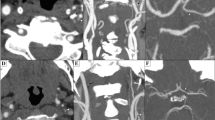Summary
The cerebral hemodynamics in patients with carotid disease is influenced by a network of extra- and intracranial collaterals. The purpose of this study was to compare the findings of regional cerebral perfusion reserve (rCPR) with angiographically proven collateral circulation. In 41 patients (28 men, 13 women, age 63 ± 10 years) with angiographically proven carotid stenoses or occlusions (30 stenoses, 11 occlusions) 24 99 mTc-HMPAO-SPECT and 25 dynamic Xe-CT investigations were conducted, both before and after acetazolamide stimulation. rCPR was quantified as the ratio (1) of the absolute rCBF values obtained by Xe-CT and (2) of the count density measured by HMPAO-SPECT of the acetazolamide administration. A rCPR of less than 95 % in a vascular territory was classified as compromised rCPR. A recent CT examination was available in all cases. According to the angiographic findings the patients could be classified into (1) group A (n = 9) with residual carotid perfusion, (2) Group B (n = 8) with collateralization via the circle of Willis, and (3) group C (n = 24) with leptomeningeal or ophthalmic artery collateral circulation. The rCPR values were significantly different in groups B and C with both methods, Xe-CT (P = 0.0035) and HMPAO-SPECT (P = 0.0014). rCPR was decreased in 13/14 group C patients investigated with Xe-CT and in 11/14 examined with HMPAO-SPECT. All patients in group B showed normal rCPR according to Xe-CT and HMPAO-SPECT. In group A, six of seven revealed decreased rCPR on Xe-CT, while rCPR values were normal in all four group A-patients examined with HMPAO-SPECT. The cerebral hemodynamics depend on a collateralization network and not only on the degree of internal carotid artery (ICA) stenosis. A decreased CPR in a vascular territory ipsilateral to an ICA stenosis or occlusion correlates strongly with the angiographic finding of leptomeningeal or ophthalmic artery collateral circulation.
Zusammenfassung
Die zerebrale Hämodynamik bei A.-carotis-interna-(ACI-)Stenosen/-Verschlüssen wird von extra- und intrarkaniellen Kollateralen beeinflußt. Ziel dieser Studie war es, die Befunde der regionalen zerebralen Perfusionsreserve (rCPR) mit angiographisch nachgewiesenen Kollateralisierungs- und Anastomosierungstypen zu vergleichen. Bei 41 Patienten (28 Männer, 13 Frauen, Alter 63 ± 10 Jahre) mit angiographisch untersuchten ACI-Stenosen/-Verschlüssen (30 Stenosen, 11 Verschlüsse) wurden in 24 Fällen eine 99 mTc-HMPAO-SPECT und in 25 eine dynamische Xe-CT jeweils vor und nach Diamox®-Stimulation durchgeführt. Für die rCPR-Quantifizierung wurde in der Xe-CT das Verhältnis der absoluten rCBF-Werte und in der HMPAO-SPECT der Zählratendichten jeweils nach zu vor Diamox berechnet. Eine rCPR < 95 % in einem zerebralen Gefäßterritorium wurde als pathologisch gewertet. Bei allen Patienten lag eine aktuelle CT-Untersuchung vor. Angiographisch wurde das Kollektiv in 3 Kollateralisierungstypen eingeteilt: Gruppe A (9 Patienten) mit karotidaler Restperfusion, Gruppe B (8 Patienten) mit Kollateralisierung über den Circulus Willisi und Gruppe C (24 Patienten) mit leptomeningealen und/oder A. ophthalmica Anastomosen. Die rCPR unterschied sich sowohl in der Xe-CT (p = 0,0035) als auch in der HMPAO-SPECT (p = 0,0014) signifikant in den Gruppe B und C: in der Xe-CT war die rCPR in 13/14 Fällen erniedrigt und in der HMPAO-SPECT in 11/14. Alle Gruppe B-Patienten hatten sowohl in der Xe-CT als auch in der HMPAO-SPECT eine normale rCPR. In Gruppe A wiesen 6/7 mit Xe-CT untersuchte Fälle eine eingeschränkte rCPR auf, während in der HMPAO-SPECT die rCPR bei allen 4 Patienten normal war. Die zerebrovaskuläre Hämodynamik hängt von der Kollateralisierung und nicht vom A.-carotis-interna-Stenosegrad allein ab. Eine eingeschränkte zerebrale Perfusionsreserve in einem Gefäßterritorium ipsilateral zu einer ACI-Stenose/-Verschluß korreliert in einem hohen Maß mit dem Vorhandensein von leptomeningealen und/oder A.-ophthalmica-Anastomosen.
Similar content being viewed by others
Author information
Authors and Affiliations
Rights and permissions
About this article
Cite this article
Reiche, W., Schäfer, R., Müller, M. et al. Comparison of cerebral perfusion reserve and collateral circulation in patients with internal carotid artery disease. Radiologe 37, 891–898 (1997). https://doi.org/10.1007/s001170050299
Issue Date:
DOI: https://doi.org/10.1007/s001170050299




